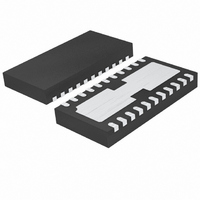LTC4090EDJC#PBF Linear Technology, LTC4090EDJC#PBF Datasheet - Page 24

LTC4090EDJC#PBF
Manufacturer Part Number
LTC4090EDJC#PBF
Description
IC USB POWER MANAGER 22-DFN
Manufacturer
Linear Technology
Datasheet
1.LTC4090EDJCPBF.pdf
(28 pages)
Specifications of LTC4090EDJC#PBF
Function
Power Management
Battery Type
Lithium-Ion (Li-Ion), Lithium-Polymer (Li-Pol)
Voltage - Supply
4.35 V ~ 5.5 V
Operating Temperature
-40°C ~ 85°C
Mounting Type
Surface Mount
Package / Case
22-WFDFN Exposed Pad
Supply Voltage Range
4.35V To 5.5V
Operating Temperature Range
-40°C To +85°C
Digital Ic Case Style
DFN
No. Of Pins
22
Msl
MSL 1 - Unlimited
Termination Type
SMD
Supply Voltage Min
4.35V
Rohs Compliant
Yes
Filter Terminals
SMD
Frequency
2.7MHz
Lead Free Status / RoHS Status
Lead free / RoHS Compliant
Available stocks
Company
Part Number
Manufacturer
Quantity
Price
LTC4090/LTC4090-5
APPLICATIONS INFORMATION
equations can be used to easily calculate a new value for
the bias resistor:
where r
sired hot and cold trip points. Note that these equations
are linked. Therefore, only one of the two trip points can
be chosen, the other is determined by the default ratios
designed in the IC. Consider an example where a 40°C
hot trip point is desired.
From the Vishay curve 2 R-T characteristics, r
at 40°C. Using the above equation, R
14.0k. With this value of R
–7°C. Notice that the span is now 47°C rather than the pre-
vious 50°C. This is due to the increase in temperature gain
of the thermistor as absolute temperature decreases.
The upper and lower temperature trip points can be inde-
pendently programmed by using an additional bias resistor
as shown in Figure 9. The following formulas can be used
to compute the values of R
For example, to set the trip points to –5°C and 55°C with
a Vishay curve 2 thermistor choose
the nearest 1% value is 13.3k.
the nearest 1% value is 1.96k. The fi nal solution is shown
in Figure 9 and results in an upper trip point of 55°C and
a lower trip point of –5°C.
Power Dissipation and High Temperature Considerations
The die temperature of the LTC4090/LTC4090-5 must be
lower than the maximum rating of 110°C. This is generally
24
R1 = 0.409 • 13.3k – 0.3467 • 10k = 1.97k
R
R
R
R1= 0.409 • R
R
NOM
NOM
NOM
NOM
HOT
=
=
=
=
r
0.409
r
2.815
3.532 – 0.3467
and r
COLD
2.815 – 0.409
r
COLD
HOT
2.815
COLD
NOM
– r
• R
• R
HOT
25C
25C
– r
are the resistance ratios at the de-
HOT
• R
NOM
NOM
25C
• 10k = 13.2k
• R
, the cold trip point is about
25C
and R1:
NOM
should be set to
HOT
is 0.5758
not a concern unless the ambient temperature is above
85°C. The total power dissipated inside the LTC4090/
LTC4090-5 depend on many factors, including input voltage
(IN or HVIN), battery voltage, programmed charge current,
programmed input current limit, and load current.
In general, if the LTC4090/LTC4090-5 is being powered from
IN the power dissipation can be calculated as follows:
where P
charge current, and I
For a typical application, an example of this calculation
would be:
This examples assumes V
3.7V, I
more than 0.5W total dissipation.
If the LTC4090 is being powered from HVIN, the power
dissipation can be estimated by calculating the regulator
power loss from an effi ciency measurement, and subtract-
ing the catch diode loss.
where η is the effi ciency of the high voltage regulator and
V
+ I
converting V
the catch diode loss, and the third term is the power dis-
sipated in the battery charger. For a typical application, an
example of this calculation would be:
This example assumes 87% effi ciency, V
= 3.7V (V
resulting in about 0.7W total dissipation. If the LTC4090-5
is being powered from HVIN, the power dissipation can
D
P
P
= 545mW
OUT
P
P
−V
−0.4V • 1−
is the forward voltage of the catch diode at I = I
D
D
D
D
= (V
BAT
= (1− η) • V
D
= (1− 0.87) • 4V • (1A + 0.6A)
. The fi rst term corresponds to the power lost in
= (5V – 3.7V) • 0.4A + (5V – 4.75V) • 0.1A
• 1−
D
⎛
⎝ ⎜
= 400mA, and I
HVOUT
IN
is the power dissipated, I
⎛
⎝ ⎜
– V
HVIN
V
V
HVOUT
BAT
12V
⎡ ⎣
HVIN
is about 4V), I
4V
to V
HVOUT
[
) • I
⎞
⎠ ⎟
OUT
⎞
⎠ ⎟
HVOUT
• 1A + 0.6A
BAT
(
• I
OUT
(
• (I
is the application load current.
BAT
+ (V
IN
BAT
, the second term subtracts
= 100mA resulting in slightly
= 5V, V
+I
IN
BAT
+I
OUT
– V
OUT
)
= 1A, I
+ 0.3V • 1A = 0.7W
]
OUT
OUT
) + 0.3V •I
)
BAT
⎤ ⎦
) • I
HVIN
= 4.75V, V
is the battery
OUT
OUT
= 12V, V
BAT
= 600mA
)
BAT
4090fc
BAT
BAT
=











